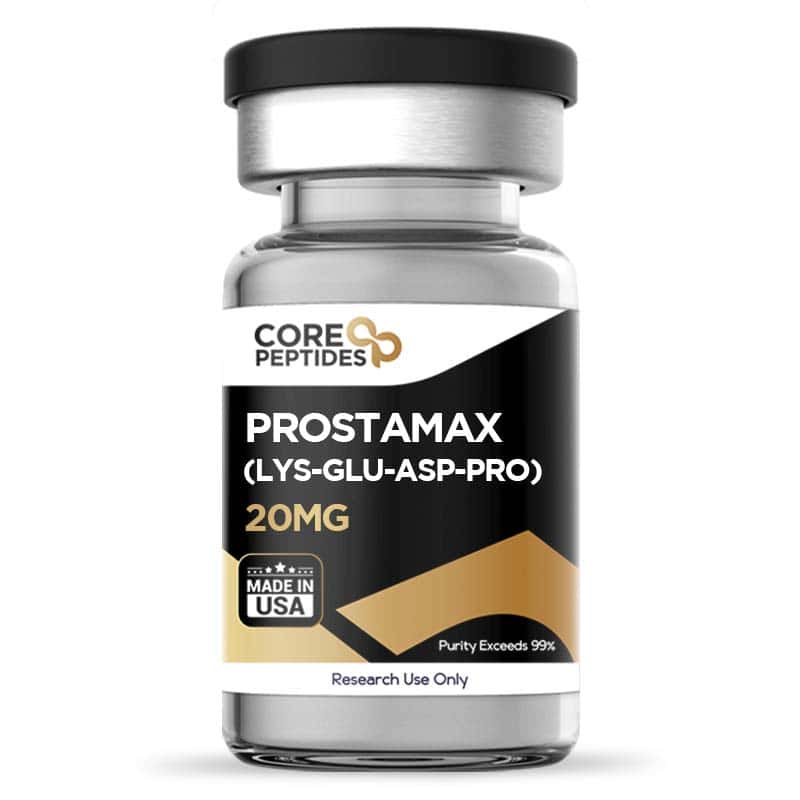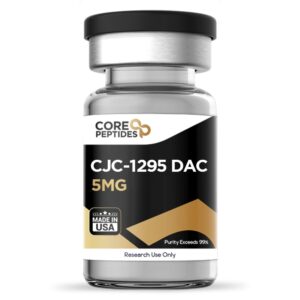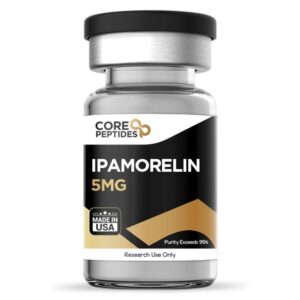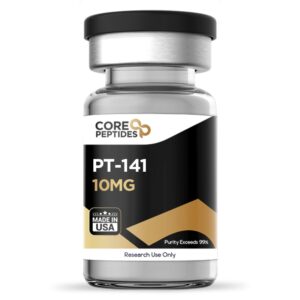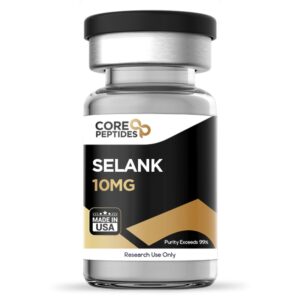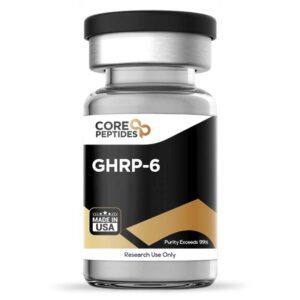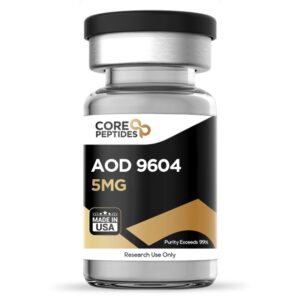Prostamax (20mg)
$63.00
Size: 20mg
Contents: Prostamax
Form: Lyophilized powder
Purity: >99%
SKU: P-PROSTAMAX-20
FREE Shipping on $200+ orders
Discount per Quantity
| Quantity | Discount | Price |
|---|---|---|
| 5 - 8 | 5% | $59.85 |
| 9 + | 10% | $56.70 |
Prostamax Peptide
Prostamax, aka KEDP, is a synthetic tetrapeptide (Lys-Glu-Asp-Pro) classified among the Khavinson peptides, which researchers have suggested may exhibit primary repair potential on various tissues, notably in prostate cell cultures. It appears to influence the structural dynamics of chromatin, potentially activating previously repressed genes and altering chromosomal dynamics. This may include increasing in the frequency of sister chromatid exchanges and Ag-positive nucleolus organizer regions, indicating enhanced chromosomal exchange activities and changes in ribosomal RNA gene activity as well as reducing the frequency of large segments of C-pericentromeric heterochromatin, suggesting a decondensation action on the chromatin. In prostatic gland tissue cultures, Prostamax may have a role in stimulating reparation processes, reducing inflammation and preventing sclerotic and atrophic processes.
Chemical Makeup
Molecular formula: C20H33N5O9
Molecular weight: 487.5 g/mol
Sequence: Lys-Glu-Asp-Pro
Other known titles: KEDP, SCHEMBL6660498
Research and Clinical Studies
The content presented here integrates recent findings from preliminary studies about Prostamax's potential, as evidenced by diverse experimental methods.
Prostamax Peptide and Gene Expression Related to Cellular Aging
One study highlights the potential impact of Prostamax on the chromatin structure in lymphocytes.(1) Chromatin, the complex of DNA and proteins found in cells, has been observed to undergo two stages of denaturation at specific temperatures and energy states, denoted as T(d)VII and T(d)VIII. Prostamax appears to induce notable changes in this chromatin structure. Specifically, it appears to cause a redistribution of heat among two endotherms, T(d)III and T(d)IV, and leads to a decrease in their temperatures by 2.9 and 1.0 degrees Celsius, respectively. This redistribution and temperature shift might be linked to a relaxation in the chromatin structure, particularly the 30-nm-thick fiber relaxing into a 10-nm filament. Furthermore, there's a suggestion that Prostamax may lead to minor structural alterations in the nucleosomal organization within the chromatin, indicated by a slight decrease in the temperatures of T(d)VIII and T(d)VII in lymphocytes introduced to Prostamax compared to control cells. These changes are possibly due to adjustments in the structural organization of both the 10-nm filament and the 30-nm fiber.
Another trial further investigates the impact of Prostamax on several chromosomal characteristics in aged cells, revealing that Prostamax possibly influences these characteristics.(2) More specifically, the study suggests that Prostamax might have a modifying action on chromatin, particularly in the context of aging cells. This could potentially lead to the activation of previously repressed genes and changes in chromosomal dynamics. For example, Prostamax apparently increases the frequency of sister chromatid exchanges (SCE). In cells introduced to Prostamax, the frequency of SCE rose to an average of 12.0 exchanges per cell, compared to 5.9 exchanges in control cells. This suggests that Prostamax may have a role in enhancing chromosomal exchange activities. Furthermore, the study posits that Prostamax may potentially increase the frequency of Ag-positive nucleolus organizer regions (NORs). In Prostamax-exposed cells, the average was 2.5 Ag-positive NORs per cell, compared to just 0.95 in intact cells. This increase might indicate changes in ribosomal RNA gene activity or chromatin structure modifications. Prostamax also seemingly reduces the frequency of large segments of C-pericentromeric heterochromatin, particularly in chromosomes 1 and 9. This change might imply a decondensation and deheterochromatinization action on the chromatin, possibly leading to the release of genes previously repressed by heterochromatinization. Ultimately, the authors concluded that “basis for the protective action of Prostamax is its modifying effect on chromatin.”
Another trial also reports that Prostamax may exhibit a potential to affect genetic processes in aging cells by modulating chromatin structure and possibly reactivating certain genes.(3) The trial focused on the potential role of Prostamax in the activation of ribosome genes, decondensation of chromatin, and altering the structure of heterochromatin. Prostamax, along with other peptides like Epitalon and Livagen, possibly led to the decondensation of chromosome 1 pericentromeric structural chromatin. This suggests that Prostamax may have a role in modulating the structure of chromatin in aging cells. The decondensation of chromatin is significant as it potentially indicates an activation of previously inactivated genes due to age-related chromatin condensation. The research posited that the peptides, including Prostamax, potentially "release" genes repressed as a result of the age-specific condensation of cellular euchromatin regions, referred to as deheterochromatinization of facultative chromatin. This implies that Prostamax may contribute to the reactivation of certain genetic activities that diminish with age. Furthermore, Prostamax possibly induced changes specifically in chromosome 1, suggesting a selective action on certain chromosomal regions. However, the exact mechanisms through which Prostamax exerts these actions, and the full scope of its potential impact on aging and age-related genetic processes, remain somewhat unclear and require further investigation.
Prostamax Peptide and the Prostate Gland
Prostamax has been the subject of research exploring its potential action on prostatic gland tissue cultures. One investigation, utilizing organotypic tissue cultures, incorporated explants from both young and aged murine models as the basis for the study.(4) The focus was to observe any possible stimulating action of Prostamax on these tissues. In the course of this research, Prostamax was introduced at a specific concentration, which was posited to potentially elicit a stimulating action on the prostatic gland tissue cultures. This action was observed when these cultures were compared to control explants, suggesting that Prostamax might have a role in stimulating reparative processes in prostatic tissues, especially during the aging process in these murine models. The authors suggested that peptide such as Prostamax may have potential “for the stimulation of reparative processes in the appropriate tissues while aging.”
Another study explored the potential of Prostamax in models of chronic aseptic prostatitis.(5) Prostamax, through experimental studies, apparently indicated a capacity to reduce the intensity of chronic inflammation, such as swelling, hyperemia of vessels, and lymphoid infiltration in murine models. The experimental setup involved murine models that underwent a procedure designed to induce chronic aseptic inflammation in the prostate gland. Post-procedure, the models were exposed to Prostamax and its impact was then evaluated in contrast to active controls. The primary goal was to gauge the potential of Prostamax in lessening the impact of chronic prostatitis and its associated complications, and to compare its potential to active controls. The authors of this study suggested that Prostamax might have the capability to diminish inflammation-related symptoms such as swelling, vessel hyperemia, and cellular infiltration commonly seen in murine models of chronic prostatitis. Notably, it also seemed to have a role in possibly curtailing the development of sclerotic and atrophic processes in the prostate gland models. These processes are typically seen as complications in such models and their potential mitigation by Prostamax is a point of interest. Prostamax's potential in preventing these processes appeared more pronounced compared to the comparator agents, suggesting its superiority in this regard. Additionally, Prostamax was observed to possibly enhance sexual activity in the animal models, a finding that may indicate broader research potential.
Prostamax peptide is available for research and laboratory purposes only. Please review and adhere to our Terms and Conditions before ordering.
References:
- Meskhi T, Khachidze D, Barbakadze Sh, Madzhagaladze G, Gorgoshidze M, Monaselidze D, Lezhava T, Tadumadze N. Vliianie peptidnogo bioreguliatora prostamaksa na geterokhromatin limfotsitov cheloveka in situ [The influence of the peptide bioregulator prostamax on heterochromatin of human lymphocytes in situ]. Biofizika. 2004 Nov-Dec;49(6):1091-3. Russian. PMID: 15612551.
- Dzhokhadze TA, Buadze TZh, Gaĭozishvili MN, Baratashvili NA, Lezhava TA. [Deheterochromatinization of the chromatin in old age induced by oligopeptide bioregulator (Lys-Glu-Asp-Pro)]. Georgian Med News. 2012 Nov;(212):76-82. Russian. PMID: 23221144.
- Khavinson VKh, Lezhava TA, Malinin VV. Effects of short peptides on lymphocyte chromatin in senile subjects. Bull Exp Biol Med. 2004 Jan;137(1):78-81. doi: 10.1023/b:bebm.0000024393.40560.05. PMID: 15085253.
- Zakutskiĭ AN, Chalisova NI, Ryzhak GA, Aniskina AI, Filippov SV, Zeziulin PN. [The tissue-specific effect of synthetic peptides-biologic regulators in organotypic tissues culture in young and old rats]. Adv Gerontol. 2006;19:93-6. Russian. PMID: 17152728.
- Borovskaya, T. G., Pakhomova, A. V., Vychuzhanina, A. V., Poluektova, M. E., Fomina, T. I., Ermolaeva, L. A., ... & Neplochov, E. A. (2013). Experimental studying of the drug efficiency Prostamax in the therapy of chronic aseptic prostatitis and its complications. Modern Research in Inflammation, 2013.
